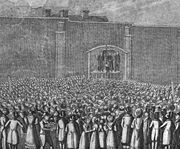
John Foxton
Encyclopedia

Hanging
Hanging is the lethal suspension of a person by a ligature. The Oxford English Dictionary states that hanging in this sense is "specifically to put to death by suspension by the neck", though it formerly also referred to crucifixion and death by impalement in which the body would remain...
of the early 19th century, a position he held for forty years.
The executioner in the city of London at Newgate Prison
Newgate Prison
Newgate Prison was a prison in London, at the corner of Newgate Street and Old Bailey just inside the City of London. It was originally located at the site of a gate in the Roman London Wall. The gate/prison was rebuilt in the 12th century, and demolished in 1777...
, among those he executed were William Corder, whose trousers and stockings Foxton was able to claim by right, and John Thurtell. On his death in 1829 he was succeeded by William Calcraft
William Calcraft
William Calcraft was the most famous English hangman of the 19th century. One of the most prolific British executioners of all time, it is estimated that he carried out 450 executions during his 45-year career...
, who had previously been his assistant.
He was also that James Foxen who, in 1818, and aged about 50 years of age, became the official hangman at Newgate Prison
Newgate Prison
Newgate Prison was a prison in London, at the corner of Newgate Street and Old Bailey just inside the City of London. It was originally located at the site of a gate in the Roman London Wall. The gate/prison was rebuilt in the 12th century, and demolished in 1777...
, having previously assisted James Botting
James Botting
Jemmy Botting was the hangman at Newgate Prison in London, England from 1817-1819 during which tenure he claimed to have hanged a total of 175 persons. He was succeeded by John Foxton who had previously been his assistant from 1818....
, the former holder of that post. Foxton/Foxen hanged 206 men and 6 women over the next 11 years. He was the hangman for the five Cato Street Conspirators
Cato Street Conspiracy
The Cato Street Conspiracy was an attempt to murder all the British cabinet ministers and Prime Minister Lord Liverpool in 1820. The name comes from the meeting place near Edgware Road in London. The Cato Street Conspiracy is notable due to dissenting public opinions regarding the punishment of the...
who became the last to suffer hanging and beheading in Great Britain
United Kingdom
The United Kingdom of Great Britain and Northern IrelandIn the United Kingdom and Dependencies, other languages have been officially recognised as legitimate autochthonous languages under the European Charter for Regional or Minority Languages...
on 1 May 1820, for conspiring to murder several members of the Cabinet
Cabinet of the United Kingdom
The Cabinet of the United Kingdom is the collective decision-making body of Her Majesty's Government in the United Kingdom, composed of the Prime Minister and some 22 Cabinet Ministers, the most senior of the government ministers....
. Foxton was assisted by Thomas Cheshire in this high profile execution and an unnamed person who actually cut off the traitors' heads.
John Foxton lived at 19 Booth Street, Hoxton
Hoxton
Hoxton is an area in the London Borough of Hackney, immediately north of the financial district of the City of London. The area of Hoxton is bordered by Regent's Canal on the north side, Wharf Road and City Road on the west, Old Street on the south, and Kingsland Road on the east.Hoxton is also a...
, and from this address on 13 May 1828 he petitioned the Court of Aldermen
Alderman
An alderman is a member of a municipal assembly or council in many jurisdictions founded upon English law. The term may be titular, denoting a high-ranking member of a borough or county council, a council member chosen by the elected members themselves rather than by popular vote, or a council...
requesting a pension as he had a weakness in his lungs caused by having performed his duties as an executioner in all weathers and now being bedridden. Being illiterate, his petition was signed with an 'X'. However, three months later he was well enough to hang William Corder in Suffolk
Suffolk
Suffolk is a non-metropolitan county of historic origin in East Anglia, England. It has borders with Norfolk to the north, Cambridgeshire to the west and Essex to the south. The North Sea lies to the east...
.
Foxton's last notable hanging
Hanging
Hanging is the lethal suspension of a person by a ligature. The Oxford English Dictionary states that hanging in this sense is "specifically to put to death by suspension by the neck", though it formerly also referred to crucifixion and death by impalement in which the body would remain...
was that of Quaker Joseph Hunton, who, along with three others, was hanged in December 1828 for forgery after a trial at the Old Bailey
Old Bailey
The Central Criminal Court in England and Wales, commonly known as the Old Bailey from the street in which it stands, is a court building in central London, one of a number of buildings housing the Crown Court...
.

